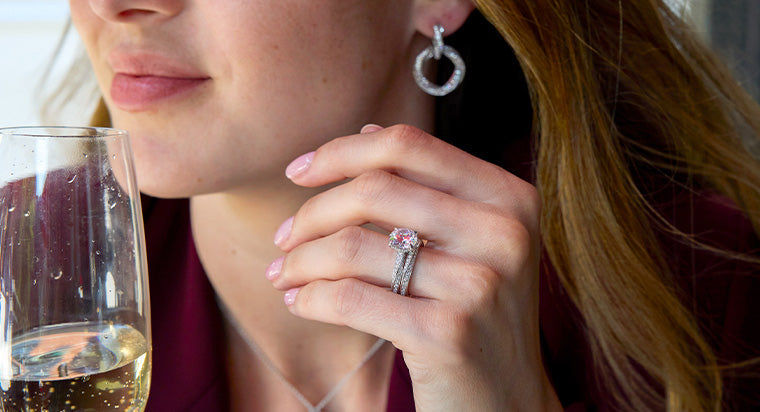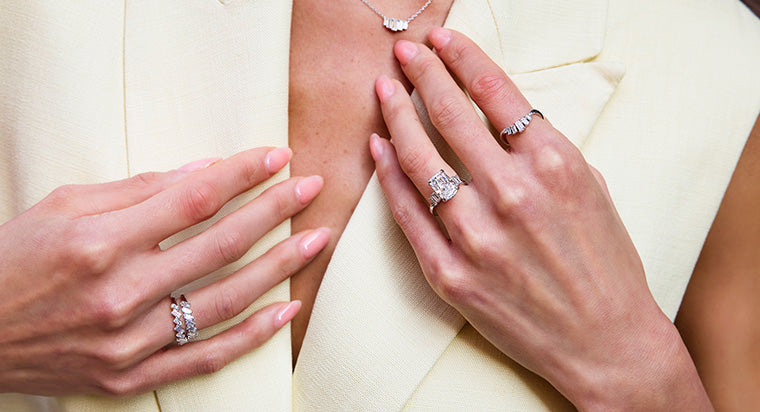The Influence of Art Movements on Jewelry Design: From Art Nouveau to Minimalism

Art movements can have a significant impact on fashion and even jewelry design. They reflect broader cultural and artistic trends that trickle down to jewelry design. If you're curious about how art movements have influenced diamond jewelry designs, see some examples of jewelry pieces.
The art movements of the past, such as Art Nouveau, Art Deco, Surrealism, Modernism, Minimalism, and Pop Art, have and continue to impact jewelry designs. Let's look at the evolution of jewelry design through the different art movements.
TABLE OF CONTENTS
Art Nouveau (1890-1910)
Known for its flowing, organic forms inspired by nature, Art Nouveau greatly influenced jewelry design. Pieces from this period often featured intricate designs with motifs such as flowers, insects, flowing lines, and animals, as well as the use of enamel, colored gemstones, and innovative metalwork techniques.
One notable designer from this time was René Lalique. René Lalique (1860-1945) was a French glass designer and jeweler. He is considered one of the foremost Art Nouveau jewelry designers, known for his innovative use of materials and techniques. Lalique's jewelry often featured natural motifs such as flowers, insects, and mythical creatures. He used delicate enamel work and settings with gemstones.
Check out these examples of current jewelry pieces that are reminiscent of Art Nouveau:
Art Deco (1920s-1930s)
Characterized by geometric shapes, bold colors, and a sleek, modern aesthetic, Art Deco had a profound influence on jewelry design. Pieces from this era often featured geometric patterns, symmetrical designs, and the use of materials such as platinum, diamonds, and colored gemstones. Designers from this time were Cartier and Jean Fouquet.
Cartier and Jean Fouquet are both iconic figures in the history of jewelry design. Cartier, founded in 1847, is renowned for its exquisite craftsmanship, innovative design, and luxurious creations that have adorned royalty, celebrities, and the elite. Cartier played a pivotal role in popularizing the use of platinum in jewelry, as well as creating iconic pieces.
Jean Fouquet was a French painter and illuminator who also made a significant impact on jewelry. His work featured intricate details, vibrant colors, and meticulous attention to detail, which translated seamlessly into the world of jewelry design. Fouquet's influence can be seen in the use of detailed enamel work.
Check out these Art Deco-inspired pieces:
Surrealism (1920s-1940s)
Surrealism's impact on jewelry profoundly inspired artists to create pieces that defied traditional notions of design and craftsmanship. Jewelry became more than just adornment; it became a medium for expressing the subconscious mind and exploring the boundaries of imagination. Surrealist jewelry often featured dream-like motifs, such as eyes, lips, and fantastical creatures, rendered in unconventional shapes, materials, and techniques. Surrealist jewelry continues to influence contemporary designers, inspiring them to create pieces that are not just beautiful but also thought-provoking and deeply meaningful.
Salvador Dalí and Elsa Schiaparelli were two influential figures in the world of art and fashion, each leaving a unique mark on jewelry design. Dalí, known for his surrealist paintings, brought his imaginative and often eccentric vision to jewelry, creating whimsical, provocative, and sometimes surreal pieces. His collaborations with jewelry designers, such as the famous "Lobster Telephone" made with Edward James, pushed the boundaries of traditional jewelry design and challenged the concept of wearability.
Elsa Schiaparelli, a pioneering fashion designer, collaborated with artists like Dalí to create bold, innovative jewelry pieces that complemented her avant-garde clothing designs. Schiaparelli's jewelry was characterized by its daring use of color, unusual materials, and playful motifs, such as her famous "shoe hat" designed with Dalí. Together, Dalí and Schiaparelli brought a sense of creativity, innovation, and artistic expression to jewelry design.
Necklace like this sapphire birthstone necklace and Marquise bezel necklace have some surrealist design elements.
Modernism (1940s-1960s)
As art and design moved towards minimalism and abstraction, jewelry design also evolved. Modernist jewelry often featured clean lines, abstract forms, and a focus on materials such as silver and stainless steel or non-traditional materials like plastics and acrylics. In terms of fine jewelry, pieces of this time focused on craftsmanship and form over decoration.
Georg Jensen and Art Smith were both influential jewelry designers of this time period who made significant contributions to the field of modern jewelry design. Jensen, a Danish silversmith, was known for his craftsmanship and innovative design aesthetic. His pieces were characterized by their organic forms, flowing lines, and use of high-quality materials, setting a new standard for modern luxury jewelry.
Art Smith, an American jewelry designer, pioneered the modernist jewelry movement in the mid-20th century. He was known for his bold, sculptural designs that challenged conventional jewelry ideas. Smith used non-traditional materials such as brass and copper, and his pieces were inspired by modern art movements like Cubism and Surrealism. You'll see modernism influences in mixed metal pieces like this mixed metal engagement ring.
Pop Art (1950s-1960s)
Pop art had a significant impact on jewelry, bringing a playful and vibrant aesthetic to the world of adornment. Inspired by popular culture, consumerism, and mass media, pop art transformed everyday objects into works of art, and jewelry was no exception. Pop art jewelry often featured bold colors, graphic patterns, and whimsical designs that reflected the spirit of the era. Artists like Andy Warhol and Roy Lichtenstein translated their iconic imagery into jewelry, creating pieces that were both artful and accessible. This stackable colored ring has a pop art vibe.
Minimalism (1960s-present)
Minimalism had a profound impact on jewelry design, emphasizing simplicity, clean lines, and understated elegance. This aesthetic shift away from the ornate and elaborate designs of previous eras brought a sense of modernity and sophistication to jewelry. Minimalist jewelry often features geometric shapes, sleek surfaces, and a focus on high-quality materials such as gold, silver, and diamonds. Artists and designers like Elsa Peretti and Sarah Graham have embraced minimalism, creating timeless pieces that are both chic and versatile. Minimalist jewelry continues to be popular, appealing to those who appreciate its refined aesthetic and timeless appeal.
Dieter Rams, known for his minimalist approach to industrial design, profoundly impacted jewelry design through his "less, but better" philosophy. His emphasis on simplicity, functionality, and elegance has influenced jewelry designers to create pieces that are not only visually appealing but also functional and timeless. Rams' design principles, such as clarity, honesty, and sustainability, have guided jewelry designers to focus on essential elements and craftsmanship, leading to the creation of enduring and meaningful jewelry pieces.
Ted Muehling, on the other hand, is a jewelry designer renowned for his organic and minimalist designs inspired by nature. His work often features delicate and intricate forms, such as branches, leaves, and insects, crafted in precious metals like gold and silver. Muehling's influence on jewelry design lies in his ability to capture the beauty and essence of the natural world in his creations, inspiring other designers to explore organic forms and textures in their work. His attention to detail and craftsmanship have set a standard for excellence in contemporary jewelry design, emphasizing the importance of quality and artistry in every piece.
Here are a few current examples of minimalist jewelry:
Conclusion
When you take a closer look at each time period, you can see the influence that the art and artists had on each era. Today's jewelry has design elements that echo pieces from the past. Contemporary jewelry designers draw inspiration from historical art movements and trends from the past. What do you think some future jewelry trends will be?















